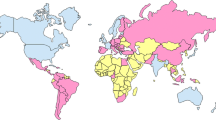Abstract
Purpose
Drug-induced agranulocytosis (DIAG) is a rare but serious adverse drug reaction. The Berlin Case–Control Surveillance Study (FAKOS) aimed to identify pharmaceuticals with an increased risk for this condition.
Methods
Adult patients with acute non-chemotherapy–induced agranulocytosis, developed in hospital or in the outpatient setting, were ascertained by active surveillance in all 51 Berlin hospitals between the years 2000 and 2010. Applying the criteria of the World Health Organization, a standardized drug causality assessment was conducted for each agranulocytosis patient to determine possible drug aetiology. Drug risks were quantified in a case–control design with unconditional logistic regression analysis.
Results
Sixty-three out of 88 validated cases of agranulocytosis were identified as being at least probably drug-related. Drug causality assessment resulted in 36 pharmaceuticals with a certain or probable relationship to agranulocytosis. Drugs involved in ≥ 3 cases with a probable or certain causality were metamizole (dipyrone) (N = 10), clozapine (N = 6), sulfasalazine (N = 5), thiamazole (N = 5), and carbamazepine (N = 3). In case–control analysis, six drugs were identified with significant odds ratios for DIAG. The highest odds ratios were observed for clozapine, sulfasalazine, and thiamazole.
Conclusions
Our findings are generally in agreement with those of earlier case–control studies. The spectrum of drugs causing acute agranulocytosis has not changed considerably over recent years, despite many newly marketed drugs. Evidence for induction of agranulocytosis by some new pharmaceuticals is supported.

Similar content being viewed by others
References
Andres E, Maloisel F (2008) Idiosyncratic drug-induced agranulocytosis or acute neutropenia. Curr Opin Hematol 15:15–21
Andres E, Zimmer J, Affenberger S, Federici L, Alt M, Maloisel F (2006) Idiosyncratic drug-induced agranulocytosis: Update of an old disorder. Eur J Intern Med 17:529–535
Andersohn F, Konzen C, Garbe E (2007) Systematic review: agranulocytosis induced by nonchemotherapy drugs. Ann Intern Med 146:657–665
Andres E, Maloisel F, Kurtz JE, Kaltenbach G, Alt M, Weber JC, Sibilia J, Schlienger JL, Blickle JF, Brogard JM, Dufour P (2002) Modern management of non-chemotherapy drug-induced agranulocytosis: a monocentric cohort study of 90 cases and review of the literature. Eur J Intern Med 13:324–328
Opgen-Rhein C, Dettling M (2008) Clozapine-induced agranulocytosis and its genetic determinants. Pharmacogenomics 9:1101–1111
Patton WN, Duffull SB (1994) Idiosyncratic drug-induced haematological abnormalities. Incidence, pathogenesis, management and avoidance. Drug Saf 11:445–462
The Uppsala Monitoring Centre (2012) The use of the WHO-UMC system for standardised case causality assessment. WHO-UMC web. http://who-umc.org/Graphics/24734.pdf. Accessed 9 May 2013
World Health Organization (WHO) (2003) The Anatomical Therapeutic Chemical Classification System with Defined Daily Doses (ATC/DDD). WHO web. http://www.who.int/classifications/atcddd/en. Accessed 9 May 2013
Ibanez L, Vidal X, Ballarin E, Laporte JR (2005) Population-based drug-induced agranulocytosis. Arch Intern Med 165:869–874
Tesfa D, Keisu M, Palmblad J (2009) Idiosyncratic drug-induced agranulocytosis: possible mechanisms and management. Am J Hematol 84:428–434
Nazer LH, Shankar G, Ali BA, Al-Najjar T (2012) Fatal agranulocytosis associated with psychotropic medication use. Am J Health Syst Pharm 69:863–867
International Agranulocytosis and Aplastic Anemia Study (1986) Risks of agranulocytosis and aplastic anemia. A first report of their relation to drug use with special reference to analgesics. JAMA 256:1749–1757
International Agranulocytosis and Aplastic Anaemia Study (1988) Risk of agranulocytosis and aplastic anaemia in relation to use of antithyroid drugs. BMJ 297:262–265
Van der Klauw MM, Wilson JH, Stricker BH (1998) Drug-associated agranulocytosis: 20 years of reporting in The Netherlands (1974–1994). Am J Hematol 57:206–211
Huber M, Kolzsch M, Rapp MA, Wulff I, Kalinowski S, Bolbrinker J, Hofmann W, Scholze J, Drager D, Kreutz R (2012) Antipsychotic drugs predominate in pharmacotherapy of nursing home residents with dementia. Pharmacopsychiatry 45:182–188
Duncan CJ, Evans TJ, Seaton RA (2010) Ceftriaxone-related agranulocytosis during outpatient parenteral antibiotic therapy. J Antimicrob Chemother 65:2483–2484
Brumage M, Trumper L, Seitz M (1987) Oral methotrexate in the treatment of rheumatoid arthritis: allergic agranulocytosis? Ann Rheum Dis 46:875–876
Serraj K, Federici L, Maloisel F, Sibilia J, Andres E (2007) Drug-induced agranulocytosis in rheumatology. A retrospective study of 12 cases. Ann Biol Clin (Paris) 65:431–436
Garbe E (2007) Non-chemotherapy drug-induced agranulocytosis. Expert Opin Drug Saf 6:323–335
Athanasiou MC, Dettling M, Cascorbi I, Mosyagin I, Salisbury BA, Pierz KA, Zou W, Whalen H, Malhotra AK, Lencz T, Gerson SL, Kane JM, Reed CR (2011) Candidate gene analysis identifies a polymorphism in HLA-DQB1 associated with clozapine-induced agranulocytosis. J Clin Psychiatry 72:458–463
Pereira A, McLaren A, Bell WR, Copolov D, Dean B (2003) Potential clozapine target sites on peripheral hematopoietic cells and stromal cells of the bone marrow. Pharmacogenomics J 3:227–234
Acknowledgments
Cases were collected within the study “Berlin Case–Control Surveillance (FAKOS) of Serious Blood Dyscrasias”, which is supported by a grant from the Federal Institute for Drugs and Medical Devices (Bonn, Germany). We wish to thank all hospitals contributing cases and controls to this study. A list of the hospitals is provided in a separate appendix.
Contributions of Authors statement
Study concept and design: Edeltraut Garbe, Elisabeth Bronder; acquisition of data: Edeltraut Garbe, Elisabeth Bronder, Frank Andersohn, Michael Thomae, Christine Konzen; analysis and interpretation of data: Edeltraut Garbe, Reinhold Kreutz, Andreas Klimpel, Matthias Huber, Frank Andersohn, Elisabeth Bronder, Michael Thomae, Christine Konzen; laboratory work: Abdulgabar Salama, Oliver Meyer; Haematology advisory board: Hubert Schrezenmeier, Martin Hildebrandt, Ernst Späth-Schwalbe, Andreas Grüneisen, Abdulgabar Salama; drafting the manuscript: Matthias Huber; critical revision of the manuscript: all authors; study supervision: Edeltraut Garbe, Elisabeth Bronder; all authors have approved the final draft submitted.
Conflict of interest
The authors declare that they have no conflict of interest.
Author information
Authors and Affiliations
Corresponding author
Electronic supplementary material
Below is the link to the electronic supplementary material.
ESM 1
(DOC 50 kb)
Rights and permissions
About this article
Cite this article
Huber, M., Andersohn, F., Bronder, E. et al. Drug-induced agranulocytosis in the Berlin case–control surveillance study. Eur J Clin Pharmacol 70, 339–345 (2014). https://doi.org/10.1007/s00228-013-1618-1
Received:
Accepted:
Published:
Issue Date:
DOI: https://doi.org/10.1007/s00228-013-1618-1




